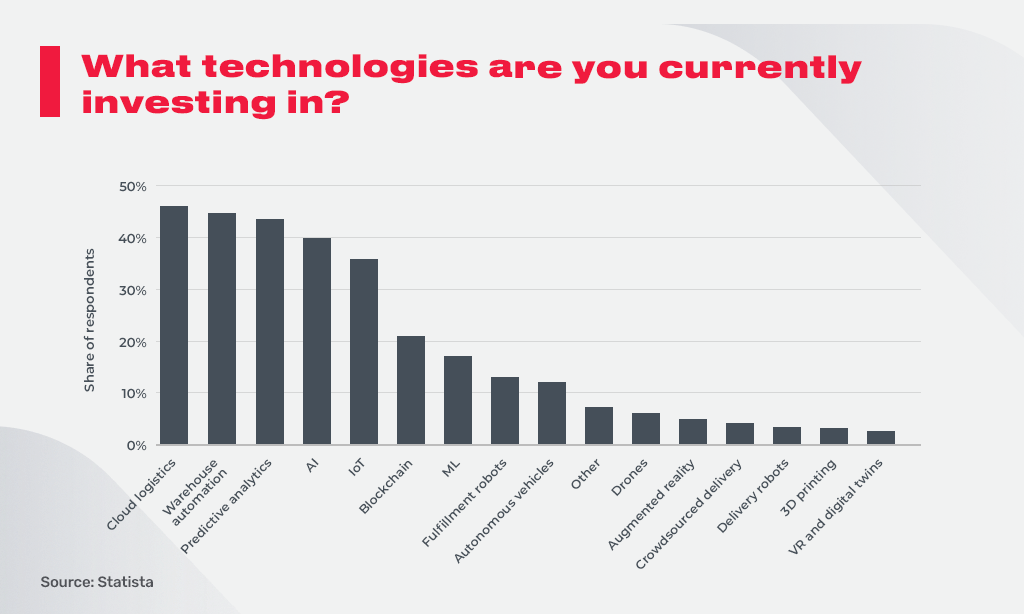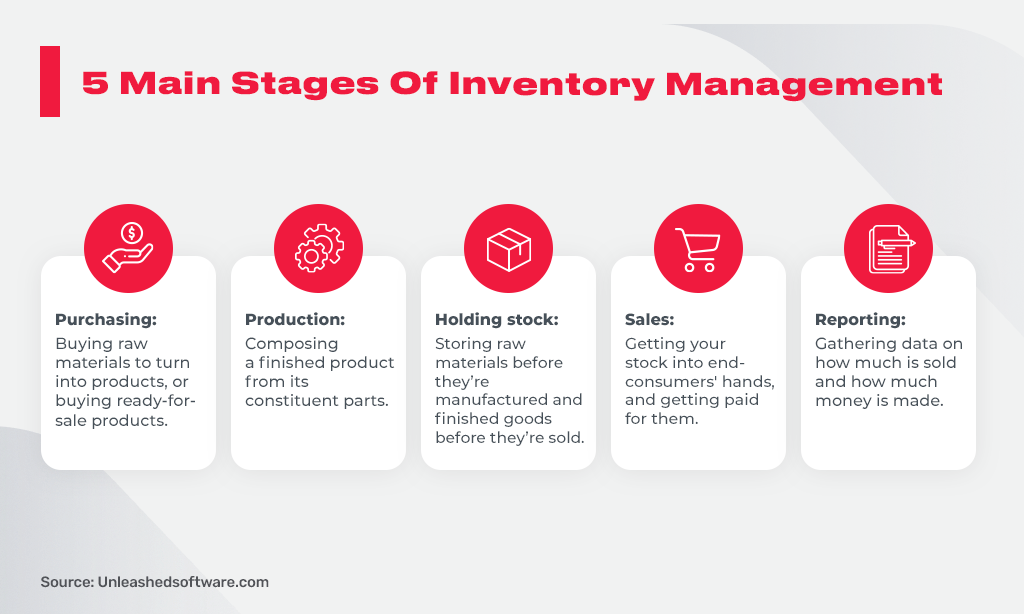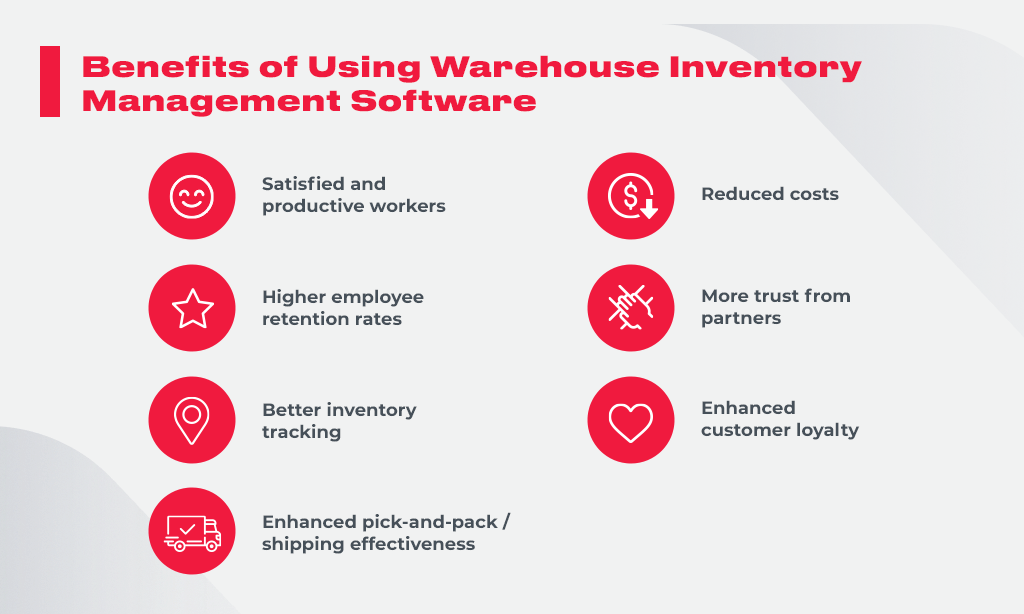How To Build An Effective Warehouse Inventory Management System
Inventory management (also known as stock management or stock control) is one of the fundamentals of a supply chain, which helps track the company’s resources and ensure they are sufficiently stocked to work correctly. Today’s main challenge for enterprises is reducing manual work involved in inventory management and saving productive hours by integrating automatic systems backed by the latest technologies.
This is why many small and midsize businesses (SMB) are interested in launching advanced warehouse management operations and are investing in inventory management software. The fact is that 46% of SMB representatives still track their stock manually or don’t do it at all. Today, the tectonic shifts in the world’s economic landscape push businesses to act in order to survive.

Almost half of the industry-leading chains are ready to invest in warehouse automation, robotics, AI and ML, and other core technologies to drive the supply chain’s performance. With these investments, SMBs make stock control a critical factor for their financial success.
Differentiating Warehouse and Inventory Management Systems
The term “warehouse inventory management” refers to tracking and controlling a company’s inventory during purchasing, production, storing, and utilization of products. It embraces the entire lifecycle of a product — from buying up to the sale to the end-user. This process’s main task is to provide a company with the right stock levels in the right location and within the given time frame.
The key difference between WMS and IMS
To proceed further, we should distinguish two terms not to use them interchangeably: inventory management system (IMS) and warehouse management system (WMS).
WMS ensures the operation of a whole warehouse, where stock management is one of the main components. Simply put, warehouse management is the broad term referring to all processes inside a warehouse, while inventory management is a narrow specialization in a supply chain process.
Since WMS and IMS can be two different and autonomous software solutions, let’s discover the key features they might contain.
WMS includes:
- Design of a storehouse: Optimization of inventory allocation and ensuring customized working process as well as an accurate selection of picking methods.
- Inventory tracking: Using specific techniques such as IoT-enabled devices, RFIDs, barcodes that allow for automatically identifying the current location of items.
- Task management: Tracking workers’ effectiveness using customized performance metrics called KPIs.
- Dock scheduling & yard management: Enabling transport drivers to quickly find the right loading bay and assisting them in cross-docking.
- Items receiving & put-away: Control of inventory’s putting away and retrieval using a pick-to-light (P2L) approach (picking items from warehouse shelves using lights to direct operators). By the way, the report states that P2L systems can improve pick rate productivity by 30–50%.
- Pick and pack process: Ensuring a more efficient operation of picking and packing goods by warehouse operators.
- Shipment procedures: Creating bills of lading, packing slips, and invoices for deliveries, sending of shipment notifications.
- Improvement measures: Generating reports based on key KPIs, warehouse operations to find gaps for improvement.
Since IMS is a part of WMS, some of their functions coincide, including pick and pack fulfillment, shipping, inventory tracking, and more. But there are also some more specific features to mention.
IMS also includes:
- Optimization of goods location: Ensuring that items are correctly placed in the warehouse, can be easily found, and accessed without eating too much space.
- Order fulfillment: Accepting inbound orders and getting them ready for completion.
- Cycle counting: Using a special inventory auditing technique that allows counting of inventory in small portions every day to keep the total amount always up-to-date.
- Asset tracking using barcodes: Providing barcode scanning of items and integrating this data with shipments, financial procedures, and other operations.
- Gathering data and generating reports: Collecting and analyzing data for creating smart measures to enhance performance and achieve more accurate decision-making.
Broadly, the difference between WMS and IMS varies from company co company. Warehouse management systems are typical for large enterprises owning at least one giant storehouse or several in different cities or even countries. On the contrary, the SMBs prefer inventory management systems as they don’t need all the capabilities of a multifunctional WMS.
Types of Inventory
Enterprises can deal with lots of inventory types, mainly depending on the products a certain company sells. The most commonplace classification you can encounter includes:
- Raw materials: The goods a company uses to manufacture finished goods.
- Unfinished goods: These products are in progress of being created and become ready for the next stage.
- End goods: The end products (or finished goods) are supplies ready for sale to the end-consumers.
- MRO (maintenance, repair, and operating) supplies: Items are used in the production process that is not ultimately seen in the finished goods themselves.
- Safety inventory: This is an additional stock stored by a company to deal with supplier shortages or fluctuations in demand.
Below you can see how the main phases an inventory usually goes through:

Benefits of Using Warehouse Inventory Management Software
The investigations of the current supply chain market show that aside from simply improving warehouse efficiency, using integrated software for managing inventory delivers additional profits for supply chains. For example, it can help you optimize and enlarge your storage space and make room for new products. It also allows for effective stock utilization and better matching supply and demand.
- Enterprises can gain a 25% increase in efficiency, a 20% increase in free space, and a 30% enhancement of stock use productivity in case they improve the pick-and-pack inventory system by switching to a more automated form of order processing.
- More than a third of supply chain experts say that the optimization of inventory management is extremely needed to balance supply and demand.

Here are some other reasons why software solutions for managing your stock are crucial for building a powerful supply chain in your company and drive its success from the long-term perspective:
Satisfied and productive workers. With WMS and IMS in place, each operator in the storehouse has a defined set of duties for each day. This makes their working day fulfilled and, as a result, employees feel satisfied with their job done.
Higher employee retention rates. Without accurate management, the storehouse operations are doomed to mess and chaos. This makes employees quit their jobs. Having integrated dedicated WMS or IMS solutions, you can reduce turnover.
Better inventory tracking. Again, it’s impossible to handle everything manually. This can lead to lost, misplaced, or even damaged goods. Stock management suggests innovative methods of precise trackings, such as QR codes, RFIDs, internet-connected devices, and more. They help to identify an accurate location and keep all products tracked and ready to set off on the journey to the customers.
Enhanced pick-and-pack / shipping effectiveness. When the allocation of items is in order, every operator knows how and where to find the needed item, the efficacy grows. The pick and pack and shipping processes become easy, seamless, and don’t eat up much time.
Reduced costs. Inefficiencies on the warehouse floor may lead to dramatic money losses. The more time you spend to prepare products for shipment, the more expensive the order processing becomes. It is best to spend more on organizing inventory and get the benefits back in the long run.
More trust from partners. Suppliers and third-party organizations are more likely to cooperate with companies that have adequately organized and effective supply chain operations. Opting for integrating a warehouse inventory management system can be the right decision to make your partners happy.
Enhanced customer loyalty. Modern consumers are demanding and want to receive their parcels within a couple of days maximum. That’s why speed in order fulfillment is vital for keeping them satisfied. IMS can aid in achieving this purpose.
Top 8 Inventory Management Techniques
The benefits described above become available for those businesses that use specific tools and practices. From large enterprises to small firms, knowing and applying these techniques might help any company to succeed:

1. Just In Time (JIT) strategy. JIT technique implies using such an IMS that supposes having stock readily available to meet customer demand. This technique doesn’t apply to storing excess inventory. JIT strategy allows for reducing cost, increasing extra space, and lowering damages of products.
Pros:
- Reduced costs for storing inventory
- Enhanced cash movement
- Less dead inventory
Cons:
- Order delivering with delays
- Minimal errors allowed
- Risk of goods deficit
2. ABC analysis approach. ABC analysis is used to classify goods based on their consumption value. A-items are products with the highest consumption level, B-items are middle-class products, and C-products have the lowest demand. This technique helps identify the products that bring revenues.
Pros:
- Allows for more accurate forecasting demand
- Allows for using time more productively and better allocate resources
- Provides multi-tiered clients support
- Ensures accurate inventory management
Cons:
- Can skip items that are just beginning to rise in demand
- Usually collides with other inventory techniques
- Is time-consuming time and labor-intensive
3. Dropshipping. It is a form of stock management that allows companies to sell goods to their end-users without storing inventory and sending orders by themselves. The provider acts as an intermediary between the end-user and the supplier. Dropshipping allows for dramatic cost savings. The eliminated inventory holding cost is a win-win situation for a business.

4. Cross-docking. Similar to dropshipping, this approach also removes the need to store inventory. As soon as goods arrive at a warehouse, they are classified and made ready for shipping. Typically, the items are reloaded into other transports at the same storehouse and sent out for shipment.
5. Bulk shipments. This model allows for a high sales rate and minimizes the risk of shortage in case of unforeseen events. Alongside cost benefits when buying items in bulk, there can be a pitfall of investing a large amount of the company budget in unpopular products.
Pros:
- Drives profitability
- Allows for fewer shipments and reduced delivery costs
- Works well for core, long-lasting goods with anticipated demand
Cons:
- Has high-risk investment potential
- Implies higher warehousing costs
- Is hard to adapt in case of surges in demand
6. Backordering. Backordering refers to a business decision to accept orders and get paid for goods that aren’t available at the moment.
Pros:
- Provides higher sales rate and faster cash movement
- Allows SMBs to be more flexible
- Reduces costs for storing and minimizes overstock risk
Cons:
- Can lead to customer disappointment
- Longer order completion times
7. Consignment. Consignment is a supply chain management strategy a consignor (supplier) provides a client-company with goods without requesting payment for them until they are sold to the end-consumers. This sounds great but this technique may have hidden risks.
Consignees (retailers, client-companies) can have some advantages:
- Broad assortment of goods to customers without limiting a budget
- Reduced latency when restocking goods
- Return unconsumed products for free
Consigners (suppliers) also take advantages of this approach:
- Experiment with new items
- Delegate marketing tasks to the consignee
- Gather data on how a product performs
Companies that prefer consignment inventory technique should take into regard the following things:
- Conditions of return, transportation, and insurance coverage
- Conditions of using and exchanging customer data
- Share of the purchase price consignee will be taking as a sales fee
8. Cycle counting. It’s a widespread approach to managing inventory where small parts of stock are counted more regularly (every day or every week) in order to avoid massive and erroneous counting once a year. This technique helps your business more accurately track inventory amounts in your warehouse management software.
Pros:
- Faster and cheaper method of counting compared to calculating a full stock
- Doesn’t hinder the workflow in a warehouse
- Allows to minimize costs for storing inventory
Cons:
- Isn’t scalable for companies that want to grow
- May not take into account seasonal fluctuations
Tips to Keep Warehouse Management System Organized
Having all the mentioned information in mind, business executives can more clearly define the strategies on how to run their inventory in the most effective way. Depending on the goals and size of the company, leaders can pick a suitable technique, decide whether they need a full-featured warehouse inventory management system or just its subset to run solely stock operations.
To help keep the warehouse organization on a decent level, you can use the tips below:
Make sure your warehouse is well-designed
The way your storehouse is designed plays a pivotal role in achieving successful inventory management. Every section should be thoroughly developed – from yard and dock to pick and pack operations. The space in a warehouse should have logic to ensure a seamless and fast workflow. An overloaded and chaotic layout makes it hard to run inventory, leaves less space for essential operations, increases the risk of employees’ errors and product losses. Take care of your warehouse and you’ll get increases in sales.
Use SKUs to facilitate operations
The inventory management system implies using unique product codes called stock keeping units or SKUs to easier find available items in stock and in specific locations. SKUs are vital for effective inventory planning, as they enable an effortless tracking of stock, including each item’s specifications (e.g., size, velocity, seasonality).
If you want to minimize the time your workers spend on finding proper goods, SKUs can be a good solution. Sort your products according to size, color, and other specifications. Also, you can zone space based on picking methods to alleviate the preparation and re-slotting of orders. Place oversized, fast-moving SKUs near to shipping sections in easily accessible locations so that operators can retrieve them faster.
Invest in automation
A warehouse management system software aims to support and streamline storehouse functionality. The modern WMS is usually underpinned by emerging techs such as robotics, VR, AR. Studies show that 50.6% of companies use warehouse robotics to run their SCM faster and efficiently.

Though many organizations are still postponing their automation initiatives, 2020 is expected to be the year where automation becomes more prioritized, as the 2019 Warehouse/DC Operations Survey states. The report shows that the manual pick and pack process decreased from 76% to 72%. Meanwhile, the use of automated solutions in warehouses grew, including goods-to-person automation, voice assistants, and automated storage and retrieval systems (ASRS).
Also, supply chain leaders believe that investing in data analysis, IoT, and cloud computing will revolutionize their supply chain operations. Applying IoT can dramatically enhance warehouse visibility as well as provide full transparency to the entire network. With IoT-connected sensors, warehouse operators can localize items faster, track the conditions of the goods in store, monitor the conditions during shipping, keep control of vehicles, and more.
Build a smooth workflow for your operators
One more essential thing in achieving effective warehouse inventory management is making the employees’ workflow clear, smooth, and more automatic (where it’s relevant). Set strict safety measures to protect your operators from being harmed, ensure regular cleaning, create a precise plan of tasks and duties. This facilitates work and enhances employee satisfaction.
In addition, warehouses supported by technologies are easier to maintain. Automation delivered by AI, robotics, ML enhances employees’ productivity. For example, 37% of companies that adopted AI in 2019 (almost thrice fold increase compared to 2015), say they reap significant benefits, including improved inventory management, manufacturing planning, and worker effectiveness. If you decide to implement brand-new tech solutions, make sure you provide your staff with sufficient training.
Conclusion: Choose The Right Vendor to Build Powerful IMS
The supply chain is a fundamental part of your company’s logistical health. With this in mind, it’s crucial to understand the ways you can improve it to keep up with demand, drive warehouse management performance, deal with shipping issues, and become an outranking player on the market of competitors. The following recommendations can help you operate your supply chain better:
- Analyze your business operations and decide whether you need a full-featured WMS software or a more specific solution for efficient inventory management.
- Learn common inventory management techniques, choose what suits you best, apply them.
- Organize your warehouse design to have a frictionless working process.
- Adopt emtechs (emerging technologies) to bring more automation. Despite being expensive, the advanced techs increase overall productivity and pay back in the long-term perspective.
- Consult a trusted custom software development provider to find the perfect solution for your business. Cooperation with professionals in designing supply chain software can help minimize risks of huge unjustified investments.
If you are ready to transform your inventory management system or build a new solution from zero, reach out to Innovecs representatives to get in-depth expertise.
